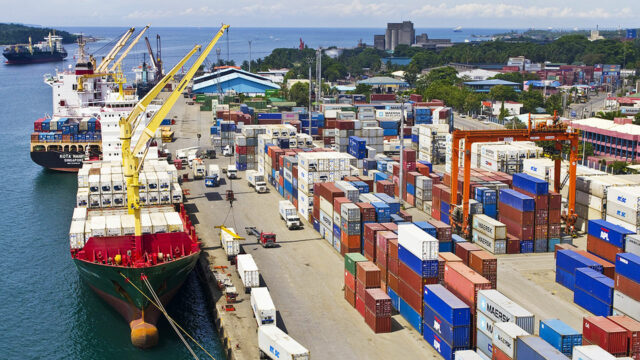Trade deficit narrows in November
By Lourdes O. Pilar, Researcher
THE PHILIPPINES’ trade deficit in November narrowed to its smallest in three months, as exports and imports both declined, data from the statistics office showed.
Preliminary data from the Philippine Statistics Authority (PSA) showed the country’s trade-in-goods balance — the difference between exports and imports — stood at a deficit of $4.767 billion in November, down by 0.04% from the $4.769-billion deficit in November 2023.
Month on month, the trade gap slimmed by 17.5% from the revised $5.78 billion in October.
November saw the narrowest trade deficit in three months or since the $4.39-billion gap in August.
Year to date, the trade deficit widened by 3.2% to $49.96 billion from the $48.41-billion gap a year ago.
In November, the value of exports declined for the third straight month, falling by 8.7% year on year to $5.69 billion from $6.23 billion a year ago. Exports dropped by 8.1% month on month.
Exports in November were at the lowest level since $5.57 billion in June 2024.
For the first 11 months, exports stood at $67.55 billion, slipping by 0.4% from $67.83 billion in the same period in 2023.
Meanwhile, imports of goods declined by 4.9% — ending four months of expansion — to $10.46 billion in November. This was a reversal of the 1.7% growth in November 2023 and the sharpest import drop since the 7.3% fall in June.
The import value in November was the lowest level in five months or since $9.89 billion in June 2024.
Year to date, imports went up by 1.1% to $117.51 billion from $116.25 billion in 2023.
For 2024, the Development Budget Coordination Committee (DBCC) expects 4% and 2% growth in exports and imports, respectively.
ELECTRONICS SLUMP
“Exports were weighed down by soft electronics performance. Imports were down due to lower dollar value of energy imports. Meanwhile capital imports were also lower as an aircraft order that drove previous months’ imports numbers faded in November,” Metropolitan Bank & Trust Co. Chief Economist Nicholas Antonio T. Mapa said in an e-mail.
Manufactured goods, which accounted for bulk of the country’s total exports receipts, fell by 12.9% to $4.43 billion in November from $5.09 billion in the same month of 2023.
Electronic products, which made up nearly two-thirds of manufactured goods and almost half of total exports, decreased by 20.8% to $2.79 billion in November.
More than two-thirds of total exports were composed of semiconductors, which also fell by 33.1% to $1.91 billion in November.
Exports of mineral products declined by 5.6% to $563.17 million in November, while exports of agro-based products jumped by 51% to $456.53 million.
The United States remained the top destination for Philippine-made goods in November, with exports valued at $969.09 million accounting for 17% of the total export sales.
It was followed by Japan with $916.12 million (16.1% share), China with $786.35 million (13.8%), Hong Kong with $600.24 million (10.5%), and Singapore with $288.11 million (5.1%).
Meanwhile, imports of raw materials and intermediate goods fell by 1.9% to $3.849 billion in November, while capital goods dropped by 3.9% to $2.911 billion.
Imports of consumer goods increased by 3.7% to $2.353 billion in November, while imports of mineral fuels, lubricants and related materials declined by 24% to $1.3 billion.
By commodity group, electronic products had the highest import value at $2.46 billion in November, up 10.5% from $2.227 billion a year ago.
China was the biggest source of imports in November with $2.82 billion worth of goods, accounting for 27% of the total import bill.
It was followed by Indonesia with $877.77 million (8.4% share), Japan with $827.75 million (7.9%), South Korea with $774.55 million (7.4%) and United States with $621.3 million (5.9%).
Sergio R. Ortiz-Luis, Jr., president of the Philippine Exporters Confederation, Inc., said in a telephone interview that many “challenges,” especially geopolitical tensions, affected the trade performance in November.
“Exports and imports of electronics, which comprise 60% of the total exports, fell the most because of geopolitical issues. Agriculture products also declined amid slow investments coming in the country,” said Mr. Ortiz-Luis in a mix of Tagalog and English.
Mr. Ortiz-Luis also said that loss of investments, particularly from China, weighed on trade.
“Although there are investments coming, the Philippines is still behind compared with other neighboring countries, amid high fuel prices, red tapes, and some government issues in the country,” he said.
Mr. Ortiz-Luis said the trade performance has been improving but “investments are lacking.”
“We are the last choice of investors which preferred more our neighboring countries,” he said.



















